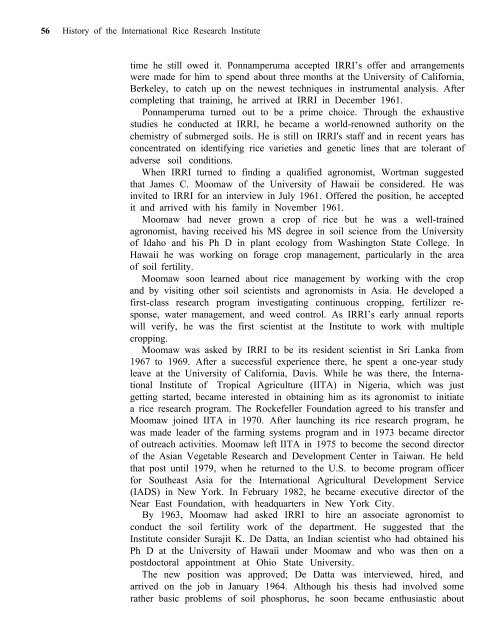An adventure in applied science - IRRI books - International Rice ...
An adventure in applied science - IRRI books - International Rice ...
An adventure in applied science - IRRI books - International Rice ...
- No tags were found...
You also want an ePaper? Increase the reach of your titles
YUMPU automatically turns print PDFs into web optimized ePapers that Google loves.
56 History of the <strong>International</strong> <strong>Rice</strong> Research Institutetime he still owed it. Ponnamperuma accepted <strong>IRRI</strong>’s offer and arrangementswere made for him to spend about three months at the University of California,Berkeley, to catch up on the newest techniques <strong>in</strong> <strong>in</strong>strumental analysis. Aftercomplet<strong>in</strong>g that tra<strong>in</strong><strong>in</strong>g, he arrived at <strong>IRRI</strong> <strong>in</strong> December 1961.Ponnamperuma turned out to be a prime choice. Through the exhaustivestudies he conducted at <strong>IRRI</strong>, he became a world-renowned authority on thechemistry of submerged soils. He is still on <strong>IRRI</strong>'s staff and <strong>in</strong> recent years hasconcentrated on identify<strong>in</strong>g rice varieties and genetic l<strong>in</strong>es that are tolerant ofadverse soil conditions.When <strong>IRRI</strong> turned to f<strong>in</strong>d<strong>in</strong>g a qualified agronomist, Wortman suggestedthat James C. Moomaw of the University of Hawaii be considered. He was<strong>in</strong>vited to <strong>IRRI</strong> for an <strong>in</strong>terview <strong>in</strong> July 1961. Offered the position, he acceptedit and arrived with his family <strong>in</strong> November 1961.Moomaw had never grown a crop of rice but he was a well-tra<strong>in</strong>edagronomist, hav<strong>in</strong>g received his MS degree <strong>in</strong> soil <strong>science</strong> from the Universityof Idaho and his Ph D <strong>in</strong> plant ecology from Wash<strong>in</strong>gton State College. InHawaii he was work<strong>in</strong>g on forage crop management, particularly <strong>in</strong> the areaof soil fertility.Moomaw soon learned about rice management by work<strong>in</strong>g with the cropand by visit<strong>in</strong>g other soil scientists and agronomists <strong>in</strong> Asia. He developed afirst-class research program <strong>in</strong>vestigat<strong>in</strong>g cont<strong>in</strong>uous cropp<strong>in</strong>g, fertilizer response,water management, and weed control. As <strong>IRRI</strong>’s early annual reportswill verify, he was the first scientist at the Institute to work with multiplecropp<strong>in</strong>g.Moomaw was asked by <strong>IRRI</strong> to be its resident scientist <strong>in</strong> Sri Lanka from1967 to 1969. After a successful experience there, he spent a one-year studyleave at the University of California, Davis. While he was there, the <strong>International</strong>Institute of Tropical Agriculture (IITA) <strong>in</strong> Nigeria, which was justgett<strong>in</strong>g started, became <strong>in</strong>terested <strong>in</strong> obta<strong>in</strong><strong>in</strong>g him as its agronomist to <strong>in</strong>itiatea rice research program. The Rockefeller Foundation agreed to his transfer andMoomaw jo<strong>in</strong>ed IITA <strong>in</strong> 1970. After launch<strong>in</strong>g its rice research program, hewas made leader of the farm<strong>in</strong>g systems program and <strong>in</strong> 1973 became directorof outreach activities. Moomaw left IITA <strong>in</strong> 1975 to become the second directorof the Asian Vegetable Research and Development Center <strong>in</strong> Taiwan. He heldthat post until 1979, when he returned to the U.S. to become program officerfor Southeast Asia for the <strong>International</strong> Agricultural Development Service(IADS) <strong>in</strong> New York. In February 1982, he became executive director of theNear East Foundation, with headquarters <strong>in</strong> New York City.By 1963, Moomaw had asked <strong>IRRI</strong> to hire an associate agronomist toconduct the soil fertility work of the department. He suggested that theInstitute consider Surajit K. De Datta, an Indian scientist who had obta<strong>in</strong>ed hisPh D at the University of Hawaii under Moomaw and who was then on apostdoctoral appo<strong>in</strong>tment at Ohio State University.The new position was approved; De Datta was <strong>in</strong>terviewed, hired, andarrived on the job <strong>in</strong> January 1964. Although his thesis had <strong>in</strong>volved somerather basic problems of soil phosphorus, he soon became enthusiastic about

















